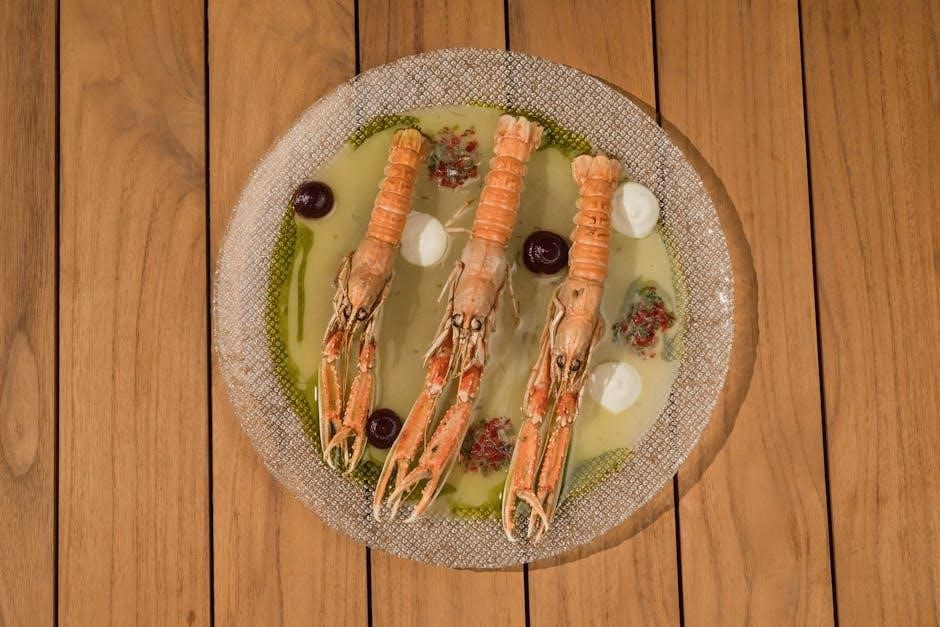The five mother sauces—Béchamel, Velouté, Espagnole, Tomato, and Hollandaise—form the foundation of French cuisine, codified by Auguste Escoffier. Each serves as a base for countless variations, shaping modern cooking techniques and flavors across the world.
Overview of the Mother Sauces Concept
The five mother sauces—Béchamel, Velouté, Espagnole, Tomato, and Hollandaise—represent the cornerstone of French cuisine, as formalized by Auguste Escoffier. Each sauce serves as a foundational recipe from which countless derivative sauces are created. Béchamel is a creamy white sauce made with milk and roux, while Velouté uses white stock. Espagnole, a brown sauce, is rich and complex, often paired with beef. Tomato sauce is vibrant and acidic, and Hollandaise is a luxurious emulsion of egg yolks and butter. These sauces are versatile and essential, forming the backbone of modern culinary techniques and flavor profiles.
History and Evolution of the Mother Sauces
The concept of mother sauces was refined by Auguste Escoffier in the early 20th century, simplifying earlier complex variations. These foundational sauces originated in 17th- and 18th-century French cuisine, with chefs like La Varenne and Carême laying the groundwork. Escoffier’s codification of Béchamel, Velouté, Espagnole, Tomato, and Hollandaise established them as the cornerstone of French cooking, influencing global culinary practices and education.
Auguste Escoffier and His Contribution
Auguste Escoffier, a legendary French chef, revolutionized culinary arts by codifying the five mother sauces—Béchamel, Velouté, Espagnole, Tomato, and Hollandaise. His work simplified the complex sauce systems of earlier chefs, making French cuisine more accessible and organized. Escoffier’s framework, detailed in his iconic cookbook Le Guide Culinaire, streamlined sauce preparation, emphasizing foundational techniques that could be adapted infinitely. His contributions not only modernized French cooking but also laid the groundwork for contemporary culinary education and practices, ensuring his legacy as one of the most influential chefs in history.

Béchamel Sauce
Béchamel is a versatile white sauce made from a roux of butter and flour, slowly cooked in milk. It’s a cornerstone of French cuisine, used in dishes like lasagna and cheese sauces.
Ingredients and Preparation Method
Béchamel sauce is made with butter, flour, and milk. Melt butter in a saucepan, add flour to create a roux, and cook until the raw flavor is gone. Gradually whisk in milk, ensuring no lumps form. Simmer gently until thickened, stirring constantly. Season with salt, nutmeg, and optional ingredients like cheese or mustard for added flavor. This creamy base is versatile and foundational in many dishes.
Common Variations and Uses
Béchamel is often enriched with cheese for a Mornay sauce, perfect for pasta or gratins. Velouté can be enhanced with cream for a richer texture, ideal for poultry or fish dishes. Espagnole, traditionally dark and robust, is a base for demis and can be simplified for modern recipes. Tomato sauce is a cornerstone in Mediterranean and Italian cuisines, used in everything from pasta to pizza. Hollandaise, while delicate, is a key component in eggs Benedict and pairs beautifully with asparagus or steak.

Velouté Sauce
Velouté sauce is made from butter, flour, and white stock, creating a light-colored, silky base. It enhances poultry and fish dishes, offering a refined, creamy texture.
Velouté sauce is crafted with butter, flour, and white stock (chicken, veal, or fish). Melt butter, add flour to make a roux, and cook until fragrant. Gradually stir in warm stock, whisking continuously to prevent lumps. Simmer gently until the sauce thickens, skimming impurities. Season with salt, pepper, and a splash of lemon juice for brightness. This silky, light-colored sauce is a versatile base for dishes like chicken or fish, offering a delicate, refined flavor profile.
Velouté sauce offers remarkable versatility, serving as a base for numerous variations. Infuse it with cream for a rich texture, or add herbs like tarragon or parsley for fresh flavor. It pairs elegantly with poultry, fish, and vegetables, enhancing dishes like chicken fricassee or poached fish. Additionally, Velouté can be seasoned with mustard or spices for a bold twist. Its light, creamy profile makes it a cornerstone in both classic and contemporary French cuisine, adaptable to various tastes and culinary needs while retaining its timeless appeal.
Espagnole Sauce
Espagnole sauce, a rich, dark brown sauce, is made with a roux, beef stock, and browned bones. It’s a cornerstone of French cuisine, offering deep umami flavor.
Espagnole sauce is crafted with butter, diced vegetables (onions, carrots, celery), flour, and dark beef stock. A brown roux is made by cooking butter and flour until golden. The stock is gradually added, simmering until thickened. Tomatoes or tomato paste are sometimes added for depth. The sauce is strained to ensure smoothness, resulting in a rich, flavorful base for dishes like demi-glace.
Espagnole sauce is versatile, often served with red meat or used as a base for other sauces like demi-glace. Variations include adding mushrooms, herbs, or wine for enhanced flavor. It pairs well with roasted meats, game, or as a foundation for rich, complex dishes. This sauce is a cornerstone in haute cuisine, offering depth and umami to various culinary creations. Its adaptability makes it a fundamental component in both classic and modern French cooking, allowing chefs to experiment with numerous derivative sauces.
Tomato Sauce (Sauce Tomate)
Sauce Tomate is a vibrant, flavorful base made with tomatoes, olive oil, sugar, and salt. It’s essential in French and international cuisine, perfect for pasta, soups, and as a foundation for other sauces.
Sauce Tomate is made with fresh or canned tomatoes, olive oil, sugar, and salt. Onions or garlic are often sautéed first for added depth. The tomatoes are then cooked until soft, creating a smooth, vibrant base. This foundational sauce is simmered to reduce excess water, resulting in a rich, slightly sweetened flavor profile. It’s a versatile base for numerous dishes, from pasta to soups, and is essential in both French and global cuisines.
Sauce Tomate is incredibly versatile, serving as a base for numerous variations. Herbs like basil or oregano can be added for an Italian-inspired flavor, while a splash of vinegar enhances depth. It is widely used in pasta dishes, soups, and stews. Additionally, it serves as a dipping sauce or a foundation for other sauces, such as Provençale or Catalan. This sauce is a cornerstone in both French and global cuisines, offering endless possibilities for creative adaptation and enhancement in various culinary contexts.

Hollandaise Sauce
Hollandaise Sauce is a rich, velvety emulsion of egg yolks, butter, and lemon juice, essential in French cuisine for dishes like Eggs Benedict and asparagus.
Hollandaise Sauce is made with egg yolks, butter, lemon juice, and salt. Sometimes, a pinch of cayenne pepper is added for flavor. The preparation involves tempering the egg yolks with warm, melted butter to create a smooth emulsion. The mixture is whisked continuously over low heat until it thickens into a creamy, golden sauce. This process requires patience to ensure the eggs do not scramble. The result is a rich, velvety texture that enhance dishes like Eggs Benedict or steamed asparagus. Proper technique is crucial to achieve the desired consistency and flavor.
Hollandaise sauce is a versatile condiment with various applications. Classic uses include topping Eggs Benedict or steamed asparagus. It pairs exceptionally well with fish like salmon or poached trout. Chefs often infuse it with herbs like tarragon or dill for added flavor. A lighter version, known as “maltaise,” incorporates orange zest and juice. Hollandaise also complements grilled meats and vegetables, offering a rich, creamy contrast. Its emulsion base makes it a popular dipping sauce for seafood. Modern culinary adaptations have expanded its use in fusion dishes, showcasing its adaptability in both traditional and contemporary cuisine.

Modern Applications of the Mother Sauces
Mother sauces inspire contemporary cuisine through creative adaptations. Chefs use them as bases for fusion dishes, incorporating global flavors and modern techniques, while maintaining their classic essence and versatility.
How Mother Sauces Influence Contemporary Cuisine
Mother sauces profoundly influence modern cooking by offering versatile foundations for innovation. Chefs adapt these classic bases to create fusion dishes, blending global flavors and contemporary techniques while preserving their timeless appeal. Béchamel, for instance, is now used in vegetarian and vegan recipes with non-dairy milks. Velouté and Espagnole form the backbone of modern gravies and sauces, while Tomato sauce remains a staple in global cuisine. Hollandaise, traditionally rich, is now lightened for healthier options. These sauces exemplify how traditional techniques can evolve, inspiring creativity and diversity in today’s culinary world.